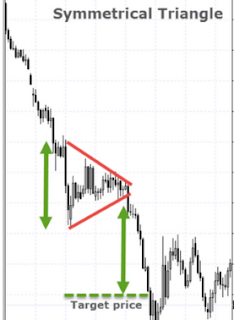Important Chart Patterns Everyone Should Know
Nse live
Chart Patterns Helpful for finding trend of stocks :
Important Chart Patterns Every
Trader Should Know Chart patterns are specific price formations on a chart that
predict future price movements. As technical analysis is based on the
assumption that history repeats itself, popular chart patterns have shown that
a specific price movement is following a particular formation of price with
high probability. Therefore, chart patterns are grouped into
A.Continuation patterns
B. Reversal patterns.
A. Continuation Chart Patterns
1. Rectangles 2. Wedges 3.
Flags
4. Triangles 5. Cup and Handle
This are more suitable for a
different style of trading- trend following. While reversal patterns are good
for contrarian traders and swing traders, continuation patterns are considered
to be great for finding a good entry point to follow the trend. The next few
patterns will reveal a new angle to trading to you.
1.Rectangle
A rectangle is a continuation
pattern, which means it confirms that the underlying trend should continue. It
is divided into bullish and bearish rectangles, depending on the underlying
trend. A bullish rectangle appears during an uptrend, when the price enters a
congestion phase, during a sideways trading. The price will likely break out in
the direction of the preceding trend. The trigger signal is the break of the
upper line of the rectangle, with the price target being the height of the
rectangle. For the bearish rectangle, the opposite rules apply. It forms during
a prevailing downtrend, when the price enters a congestion phase and trades
sideways. This means the trend will most likely continue downwards, with the
break of the lower rectangle line. The price target is again the height of the
rectangle.
2.Wedge
A wedge is another continuation
pattern. A bullish wedge forms during an uptrend, as the price trades inside
converging trendlines. These converging trend lines imply that sellers are
trying to push the price lower, but don’t have enough strength to win against
the buyers. Ultimately, the buyers win and the price breaks through the upper
trendline, indicating that the uptrend will resume. Target prices are
calculated as the maximal height of the wedge, which is then projected to the
point of break-out. A bearish wedge is similar to a bullish one, with the
difference that it is appearing during downtrends, and the slope of the wedge
is up. Converging trendlines are again showing that buyers interrupted the
downtrend, trying to push prices higher. A break-out through the lower
trendline indicates that sellers won the battle, and the downtrend is resuming.
The target price is, like by bullish wedges, the maximal height of the wedge
which is then projected to the point of break-out.
3.Flag
A flag is very similar to a
wedge, with the difference that the trendlines which form the flag are
parallel, and not converging. A flag pole is also a part of the flag pattern,
because the target price is measured in a different way than by other chart
patterns. Flags can be bullish and bearish, with a bullish flag shown on the
chart above. A bullish flag forms during an uptrend, with parallel trend lines
above and below the price-action, which form a down slope. A break-out above
confirms that the uptrend is resuming. A bearish flag is pretty much the same
as a bullish flag, with the difference that it forms during downtrends and has
an up slope. The price target is measured as the height of the flagpole to the
top of the flag, which is then projected to the lowest point of a bullish flag .
4.Triangles
Triangles can be ascending,
descending and symmetrical. All three types of triangles look pretty much the
same, with the difference that ascending triangles have a flat upper trendline,
and descending triangles a flat lower trendline. A symmetrical trendline is the
most common, and forms during both up- and downtrends. It has converging
trendlines, just like a wedge pattern, but the slope is neither pointing up or
down. The breakout point of the lower trendline during downtrends confirms that
the downtrend is resuming, while a breakout of the upper trendline during uptrends
confirm the underlying uptrend. The target price is the height of the triangle,
projected to the point of the breakout.
5. Cup and Handle
A Cup and
Handle pattern is a Rounding Top pattern with an additional pullback (the
handle). It is a continuation pattern which shows that in middle of an uptrend,
the sellers tried to push the price lower, but the sentiment is again gradually
changing from the sellers to the buyers. Additionally, a pullback occurs as the
last attempt of the sellers to dominate. After a break-out of the resistance
line (green dotted line), the target price is calculated as the height of the
Cup & Handle pattern. An Inverse Cup & Handle pattern appears during
downtrends, and the inverse rules of a regular Cup & Handle apply for it.
Source :InternetNse live scanner Real Time scanners








No comments